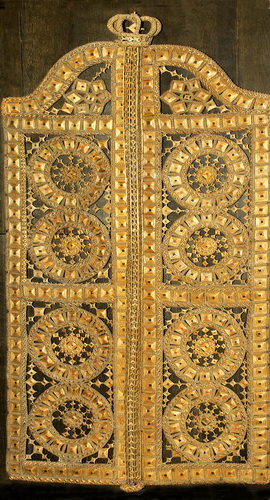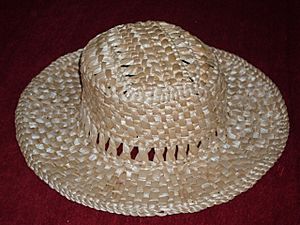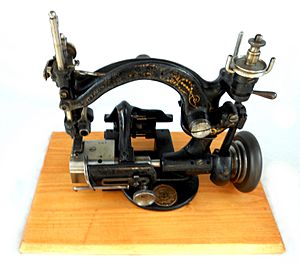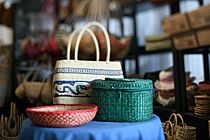Straw plaiting facts for kids


Straw plaiting is a way of making fabric by braiding or weaving straw. It's also the name for the industry that creates things from straw. People use straw plaiting to make items like straw hats and decorations. This craft is practiced in many places around the world.
Contents
What Does "Plait" Mean?
The word "plait" means to fold, gather, or braid something. It comes from an old French word, pleir, which meant "to fold" or "to bend."
What Can You Make with Straw Plaiting?
Straw can be braided for many different uses. It can be used for:
- Making thatching for roofs.
- Creating material for making paper.
- Decorating small surfaces, like a "straw-mosaic."
- Weaving into door mats and table mats.
- Filling mattresses.
- Braiding into light baskets.
- Making artificial flowers.
- Producing bonnets and hats.
Straw Plaiting in England
In the past, straw plaiting was a big job for thousands of women and children in parts of England. These areas included Buckinghamshire, Bedfordshire, Berkshire, and Hertfordshire. However, by the early 1900s, this work had mostly disappeared. In 1907, only a few hundred English plaiters remained, down from 30,000 in 1871.
The areas around Luton in Bedfordshire were the main center for straw plaiting in Britain. This started in the 1600s. The straw from certain types of wheat grown there was known for its bright color, strength, and toughness.
How Straw Was Prepared in England
First, the straw was cut like during a normal harvest. Then, it was left to dry in the sun before being tied into bundles. Workers would pick out straws from these bundles. They mainly used the top two sections of the straw stalks for plaiting.
The straw pieces were sorted by size using a special wire frame with different-sized holes. Straws with good color were bleached using sulfur fumes. Any spotted or discolored straws were dyed. Plaiters worked with damp straw, either whole or split. To split straws, they used a small tool with a point that went into the straw. This tool had tiny knife-like cutters that split the straw into thinner pieces. After splitting, the straws were flattened with a small machine called a mangle. Finally, they were braided into woven strips. These strips were then sold to people who made hats, baskets, and other items.
Social Impact and Decline
Women and children did most of the plaiting. They learned these skills in special "plait schools." At its busiest time in the early 1800s, a woman could earn more money from plaiting than a man could earn working on the land. Some people worried that this industry made men lazy.
The English straw plaiting industry eventually ended because of free trade starting in 1860. This allowed cheaper plaits from Italy, and later China and Japan, to be imported.
Straw Plaiting in Tuscany
In Tuscany, Italy, some of the best straw for plaiting is grown. This straw is used to make the famous Tuscan plaits and Leghorn hats. The straw grown for plaiting in Tuscany comes in three main quality levels:
- Pontederas Semone: The highest quality.
- Mazzuolo: The second highest quality, used for most plaits.
- Santa Fioro: The third quality, used only for "Tuscan pedals" and braids.
How Tuscan Straw Is Prepared
The wheat seeds for these straws are planted very close together on high, dry land. This makes the stalks grow long and thin. When the grain in the ear is about half-grown, the straw is pulled up by its roots. It is then dried in the sun. After that, it is spread out for several days to be bleached by sunlight and night-time dew. Only the top section of the straw stalk is chosen for plaiting. The rest of the straw is used for other things. These chosen stalks are bundled, bleached with sulfur fumes, and sorted by size. Then they are ready for the plaiters.
Tuscan Plaiting as a Home Industry
Straw plaiting is a home-based job for women and young children in Tuscany and parts of Emilia. Tuscan plaits and hats can be very different in quality and price. A good quality hat might take four or five days to plait. The very best hats can take six to nine months to make! This fine work is very hard on the plaiters' eyes, so they can only do it for two or three hours each day.
Straw Plaiting in China (Tang Dynasty)
Xuhang straw plaiting comes from Xuhang, Jiading, and has a very long history. Over 1,000 years ago, during the Tang Dynasty, braided yellow grass was already a special gift for the royal court. In 1914, an Italian company hired two people from Xuhang, Wang Jihe and Zhu Shilin. They bought yellow grass plaits from local farmers and sold them in Southeast Asia, Europe, and the United States. This is how Xuhang yellow grass plaits began to be known around the world.
As Xuhang's influence grew, the artistic side of its straw plaiting also improved. Artists like Li Yueqin designed beautiful items, such as dove of peace slippers. Thanks to the efforts of artists like Xu Xing, who worked to keep this unique folk art alive, Xuhang town was named the "Hometown of Chinese Folk Art" in 1994 by China's Ministry of Culture. In 2008, Xuhang straw plaiting was added to the National Intangible Heritage List.
Today, people from all over the world visit the Xuhang Straw Plait Heritage Museum and Studio in Jiading, Shanghai. They can learn about the ancient history of how Xuhang straw was planted, harvested, and turned into beautiful and useful art. This art has been very important in the daily lives of ordinary people in China, both long ago and now. It is used for straw slippers, hats, baskets, and mats.
Straw Plaiting in Oceania (1896)
Friedrich Ratzel, a writer, described plaiting in Oceania in his book The History of Mankind. He noted that plaiting was done very carefully.
- Coarser mats: Made from coconut fiber.
- Finer mats: Made from pandanus leaves and rushes.
A skilled Fijian could tell which island a mat came from just by looking at it. The thicker mats were used as floor coverings and wall hangings in huts. The finer ones were used as sails, sleeping mats, or for children. Floor mats could be 5 to 8 yards long, and sail mats could be 100 yards or more.
Sleeping mats came in two types: a thicker one to lie on and a thinner one for covering. Some highly valued mats had a special fold running through the middle of each braided strip. Borders were decorated with designs in darker colors. White feathers and small pieces of European cloth were sometimes woven in.
One very pretty item was the women's liku, a belt woven from strips of wau-tree bark (a type of hibiscus). It also used fibers from a wild root and blades of grass. Soft mats were made by braiding the stalks of a fibrous plant. The woody parts were removed by bending and beating them. Bags and baskets were woven very well. Fans were also made from palm leaves or woven from bark.
However, the best items were the string and cables. The best ones were made from coconut fiber, and the less good ones from wau-tree bark. In the Fiji Islands, these were neatly rolled into balls, ovals, or spindles. Comparing this to New Caledonia shows how good East Melanesia was at this art. For example, a fan from Fiji was much better than one from New Caledonia. In New Guinea, many elegant woven items were also produced.





